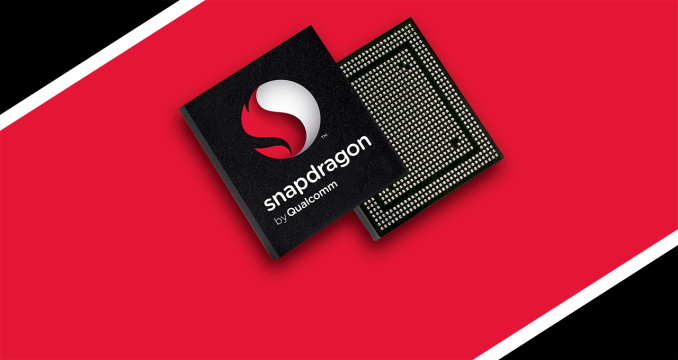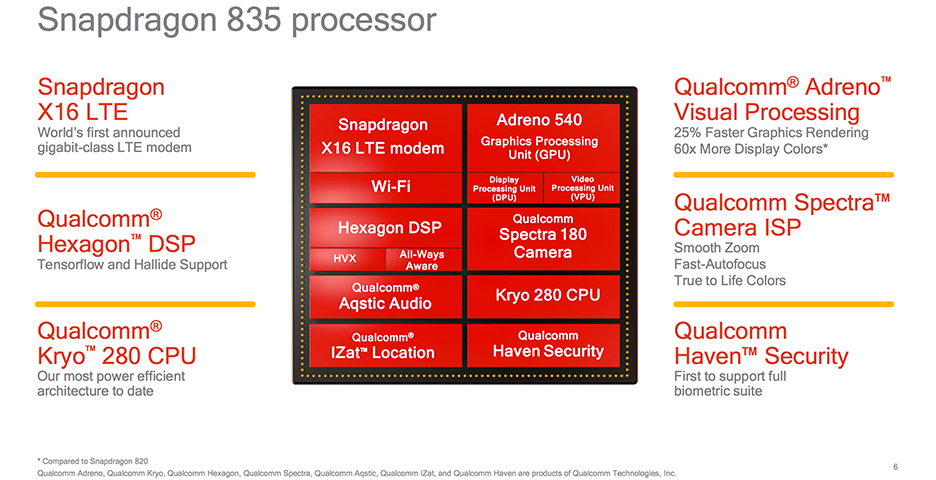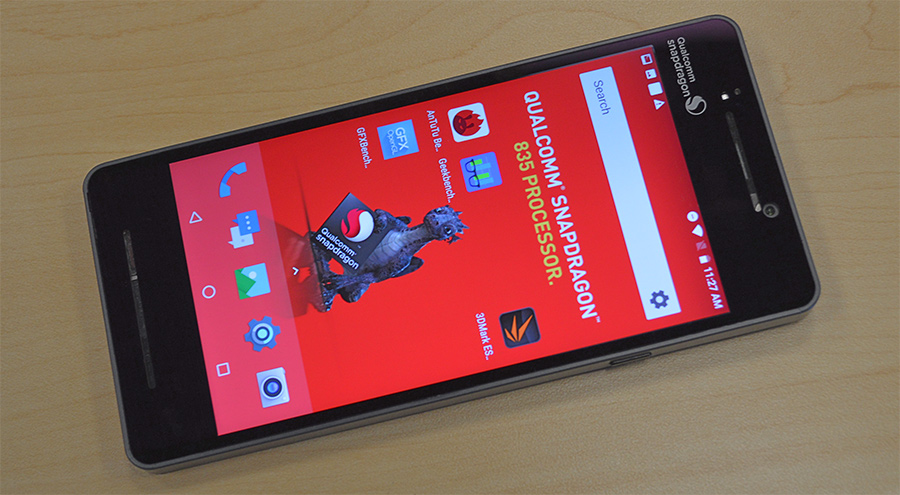The Qualcomm Snapdragon 835 Performance Preview
by Matt Humrick & Ryan Smith on March 22, 2017 4:30 AM EST- Posted in
- Smartphones
- Snapdragon
- Qualcomm
- Mobile
- SoCs
- Snapdragon 835
- Kryo

The Snapdragon 820 SoC was a significant milestone on Qualcomm’s roadmap. It was a solid improvement over the 808/810, delivering higher performance and efficiency, and became a commercial success, finding its way into the majority of flagship phones last year. More importantly, it heralded Qualcomm’s vision for mobile devices: heterogeneous computing. This meant new hardware—a much improved Hexagon 680 DSP that added single instruction, multiple data (SIMD) Hexagon Vector Extensions (HVX); Qualcomm’s first fully-custom 64-bit CPU core, Kryo, which focused on improving floating-point IPC; and an updated Adreno GPU with strong ALU performance—for enabling new software technologies and user experiences—artificial intelligence for smarter personal assistants, machine learning for object recognition, computational photography for better image and video quality, and new AR/VR experiences.
Snapdragon 835—now a part of Qualcomm’s Snapdragon Mobile Platform that includes all of the company’s mobile hardware and software—is an evolutionary product that builds on this vision. The greater than 3 billion transistor SoC is the first to use Samsung’s 10nm "10LPE" FinFET process, which reduces overall package size by 35% relative to Snapdragon 820. The new SoC’s CPU transplant and X16 LTE modem, which tops out at 1Gbps (Category 16) on the downlink, are the biggest changes, but most of the other blocks within the SoC have received at least minor updates too. For detailed information about all the changes and new features, you can read our Snapdragon 835 launch article.
| Qualcomm Snapdragon SoCs: Three Generations | |||
| SoC | Snapdragon 835 (MSM8998) |
Snapdragon 820 / 821 (MSM8996 / MSM8996 Pro) |
Snapdragon 810 (MSM8994) |
| CPU | 4x Kryo 280 Performance @ 2.45GHz 4x Kryo 280 Efficiency @ 1.90GHz |
2x Kryo @ 2.15GHz / 2.34GHz 2x Kryo @ 1.59GHz / 2.19GHz |
4x Cortex-A57 @ 2.00GHz 4x Cortex-A53 @ 1.50GHz |
| GPU | Adreno 540 @ 710MHz ? | Adreno 530 @ 624MHz / 653MHz | Adreno 430 @ 630MHz |
| Memory | 2x 32-bit @ 1866MHz LPDDR4x 29.9GB/s |
2x 32-bit @ 1866MHz LPDDR4 29.9GB/s |
2x 32-bit @ 1600MHz LPDDR4 25.6GB/s |
| ISP/Camera | Dual 14-bit Spectra 180 ISP 1x 32MP or 2x 16MP |
Dual 14-bit Spectra ISP 1x 25MP or 2x 13MP |
Dual 14-bit ISP 1x 21MP |
| Encode/Decode | 2160p30 (2160p60 decode), 1080p120 H.264 & H.265 |
2160p30 (2160p60 decode), 1080p120 H.264 & H.265 |
2160p30 (2160p60 decode), 1080p120 H.264 & H.265 |
| Integrated Modem | Snapdragon X16 LTE (Category 16/13) DL = 1000Mbps 3x20MHz CA, 256-QAM UL = 150Mbps 2x20MHz CA, 64-QAM |
Snapdragon X12 LTE (Category 12/13) DL = 600Mbps 3x20MHz CA, 256-QAM UL = 150Mbps 2x20MHz CA, 64-QAM |
Snapdragon X10 LTE (Category 9) DL = 450Mbps 3x20MHz CA, 64-QAM UL = 50Mbps 1x20MHz CA, 16-QAM |
| Mfc. Process | 10nm LPE | 14nm LPP | 20nm SoC |
In what has become an annual tradition going all the way back to Snapdragon 800, Qualcomm invited the media to its headquarters in San Diego for some feature demonstrations and limited testing using the company's Mobile Development Platform (MDP) devices. These are fully functional tablets or smartphones in a slightly oversized, utilitarian chassis used for hardware testing and software development. The MDP for Snapdragon 810 took the form of a tablet, while Snapdragon 820 came inside a large smartphone with a 6.2-inch display. This downsizing trend continues for Snapdragon 835, whose MDP/S is a smartphone with 6GB of RAM, a 5.5-inch 2560x1440 display, and a small 2850 mAh battery. The use of a smaller chassis is encouraging, because it has less mass and surface area to absorb and dissipate heat. This suggests a lower TDP for the 835, but we'll need to measure power consumption to be sure.
Because we only had a limited time for testing, we focused on running some basic CPU, GPU, and memory performance tests. Keep in mind that we were testing prototype hardware running pre-production software that resulted in a few hiccups. The condensed testing period also forced us to stray slightly from our usual testing methodology. Therefore, these numbers should be viewed as preliminary and could change by the time retail units begin shipping.












128 Comments
View All Comments
joms_us - Thursday, March 23, 2017 - link
Well not quite 100% to me... Hell knows what background app is making those spikes and not Geekbenchhttp://i.imgur.com/IjBdsOHh.jpg
http://i.imgur.com/6FWmG5Jh.jpg
http://i.imgur.com/IjMsOjIh.jpg
Remember the news about benchmark cheating of Samsung and now Oneplus? What they did are perfectly valid because a worthless app like Geekbench does not measure the true IPC of the SoC if it can't maximize it. You go to Windows world, people will disable CnQ or Speedstep and Powernow just to make sure processor is running at 100% of frequency to measure true IPC.
P.S Thanks for the name of the app, I appreciate it!
realbabilu - Sunday, March 26, 2017 - link
I remember in Windows Pc,is hard to get all cores stay flat at 100% unless I got very good multithread multiprocessor designed program like Ansys or Abaqus. Means its very tough to get/program a software that can utilize all cores stay at 100%.
ah06 - Wednesday, March 22, 2017 - link
Please stop posting, your understanding of SoCs is less than primary school level and you are talking to experts like Andrei........ah06 - Wednesday, March 22, 2017 - link
Why are you on Anandtech? How old are you?Please do not post again
joms_us - Thursday, March 23, 2017 - link
Oh some God from heaven, sorry for stopping by here.lilmoe - Thursday, March 23, 2017 - link
lol, I was literally being sarcastic in my comment. Looks like it stirred a lot of angry replies.- Geekbench does scale well across all cores. That's not the problem. Geekbench sucks as a benchmark for "absolute" performance of the CPU portion of an SoC (or platform like QC likes to call it) that matters for modern workloads. In addition to that, the way it calculates the totals and how the devs decide what sub-score counts more than what is absolute BS. Most of the workloads it tests are rarely dealt with the CPU and more commonly offloaded to co-processors. Yes, even on iOS devices. I find the compute portion of geekbench rather interesting, but it's rarely discussed by anyone.
- CPUs are getting less and less relevant in modern content consumption workloads. Offloading to co-processors, if at all possible, is the way to go. For instance, Intel's latest 7700K CPU (cpu only) pales in comparison to the least efficient 4K encoding/decoding block implementation on any modern platform, including ARM based SoCs. The same goes for image processing/manipulation, audio, speech recognition, security, etc, etc.... You know, the sub-tests that Geekbench performs.
- Interconnect, bandwidth, cache throughput and latency, and Scheduling play a huge part in the multi-core score of a CPU/SoC. Generally, the more cores you have, the harder and more power consuming it is to scale multiple threads across those cores, _especially_ on processors constrained with a 2-4 watt power envelope. Those caches are very power hungry and often limit scaling by 10-20% of ST even on non-power limited CPUs. That percentage is much, MUCH higher on ultra mobile ARM parts.
- In addition to those scaling issues, the Snapdragon 835, similar to Samsung's Exynos and HiSilcon's Kirin SoCs are big.LITTLE multi-cluster configurations. Typically, only 1 of these clusters is high performance, and only when you're running a single or couple of threads would the high performance cores reach their highest clocks. That's by design of ultra-low power, passively cooled parts. The Exynos 8890 gets up to 2.6Ghz in ST and 2.2Ghz in MT. Again, in addition to clock variance, you'll never get 8x ST since only 4 of those 8 cores are high performance. The smaller cores are nowhere near as powerful. I say they would count as Intel's virtual threads in their hyper threading (SMT), and should help to achieve better scaling by just a tiny bit.
So, yea. I was being sarcastic. I agree with Qualcomm. These modern ARM SoCs are very sophisticated and tricky to benchmark. Nothing about them is simple. What ultimately matters is how much time it takes them to complete a modern workload, and how much power they consume at that. The more of these workloads are offloaded to co-processors, the better.
For the CPU portion, what matters in a smartphone/tablet, first and foremost, is multi-core performance, and how much of that performance is sustained over time with the least amount of power consumption. ST performance is overrated doesn't matter, AT ALL, after a certain performance threshold IN MOBILE DEVICES. Split second javascript gains as a result of browser optimization or real ST lead of a particular SoC are irrelevant. Javascript doesn't exist in a vacume, it's part of a web page/app, and how long it takes a browser to fully load a page and render its content is what ultimately matters. Period.
tuxRoller - Thursday, March 23, 2017 - link
"I find the compute portion of geekbench rather interesting, but it's rarely discussed by anyone."Why is that the case?
Btw, this is a much better comment.
What you are saying is why relevant benchmarks don't exist for mobile devices (sub-laptops).
The issue, i believe, is that sites, largely, test these devices like small computers (bear with me). As such, they focus on cpu related tasks. Some sites include video recording/playback power usage, but none, tmk, include task traces that are taken from someone actually using a device.
tuxRoller - Wednesday, March 22, 2017 - link
If all you care about is a running a headless server that can't communicate with the outside world, then, yeah!If you care about battery life and good performance, low power processors (microcontrollers or tiny a series cores used for handling interrupts or more general duties when in a low power state), dsps and gpus matter.
Do we need a hashtag?
prisonerX - Wednesday, March 22, 2017 - link
Yeah those graphics co-processors, what a joke.wardrive2017 - Wednesday, March 22, 2017 - link
Again I am impressed by the Snapdragon 625 showing here in the cpu tests, particulary in the PC mark tests, not so much in the Javascript. Still performing much better than expected. The G5 plus is starting to look quite appealing assuming its tweaked the same ways the Moto z play is